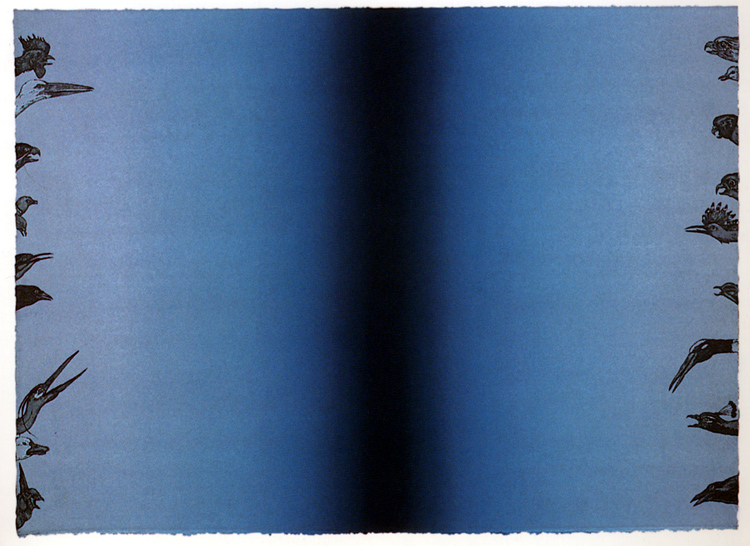
1996
soft-ground etching, aquatint and lithograph on black German Etching Paper, printed by Vinalhaven Press
20 x 30 inches
The following is from the publication “In Print: Contemporary Artists at the Vinalhaven Press,” Aprile Gallant, Portland Museum of Art, Maine, 1997:
“The Language of Birds grew out of the artist’s experiments with etching, and was inspired by the poem Manteq al-Tiar (The Conference of the Birds), by the twelfth century Persian poet Farid Un-Din Attar. Attar’s poem relates the story of a meeting amongst the birds of the world who are in search of a “king.” They undertake a quest to find this leader, whom they question through their journey. At the end of the voyage, they find that the king they seek is themselves.
Manteq at-Tair is based on the teachings of Sufism, a mystical Islamic doctrine of which the poet was a proponent. The tenets of Sufism were not written down, as it was believed that the only way to learn them was a prolonged apprenticeship with a spiritual leader. It is an inward system of belief; the earthly realm is considered God’s “shadow,” and only through reflection into the self (as a “shadow” of divinity) can a follower be led to a recognition, and “self-annihilation” through alliance with God. The word “shadow” is key to Chin’s conception of the poem. While on Vinalhaven, Chin wrote “SONGS TO THE SHADOWS…” in the margins of a copy of Dick Davis’s introduction to a translation of the poem.
Rather than a congress, Chin’s print The Language of Birds displays a deep break. Disembodied bird heads at the margins call toward a black shadow that divides the center of the paper. This configuration also suggests a lack of communication – the birds of the world become the people of the world, individually calling, in different voices, for life’s meaning. It is not necessary to know the genesis of Chin’s images to make sense of their message. The open, squawking mouths of the birds, separated from their fellows and pointed toward a limitless void, is an evocative image that few could misinterpret. The Language of Birds is the ultimate Venus flytrap, an exploitation of the sensuous materials of printmaking to impart a pointed message.”